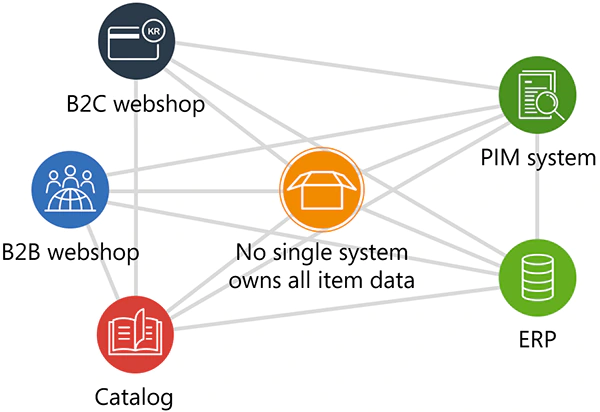How to handle data for e-commerce today
Data can be extremely annoying when working with e-commerce.
Of course, I like the fact that there is a lot of data about the products, but it is a heavy task to update data manually, especially when you have to make sure that data is accurate and up to date in all systems.
Currently, I experience a clear trend for companies to gather data in a certain way.
… and I’ll tell you about that in a moment, but first, we need to talk about what reality looks like in most companies.
Data is unfortunately maintained in many different places
You probably have the same product data in many different systems. You have items in your ERP solution, master data on the items in the PIM system, item data and inventory data in the webshop, and you may have two sets of them because you work with both B2B and B2C, and maybe even three because you have a printed catalog of all the items, etc.
We often see that there is data in many different places. And they are even fragmented and not logically connected.
All item numbers, prices, and inventories are in the ERP system. Descriptions, pictures, and videos are placed on the webshop, and in addition to that, you probably have a universe of experience in a CMS system that is also about your products.

Spending your day typing
If there is new data about an item, you enter it manually into the ERP system and the data entry operators enter into the web shop. The marketing department copies it into the catalog the next time they print it or update the PDF. Everybody type and type …
By the way, you have to wait until next week to get the PIM system updated, because only Jennifer knows how to do it and she is on vacation this week.
I know, it sounds crazy, but this is the reality I meet again and again with the companies I visit.
The dream of automation
I would like to tell you a little anecdote 🙂
I helped establish a web shop selling sports equipment, and it turned out that the suppliers in the sports industry have a blast with spreadsheets in different formats and word documents. Data were unstructured and inaccessible.
When we had to order items, we had to call one supplier, write to the other and enter information in a shop at the third supplier.
We just wanted data and orders to be processed automatically without all the manual handling. It was difficult back then. But this is also one of the reasons why I am so pleased with the trend that is taking place in the ecommerce market right now.
New trend in e-commerce
I find that companies can no longer live with the heavy manual processes and having to enter the same item data in several different systems. It’s a waste of energy.
The trend consists of 3 steps:
- Today, companies move the PIM system into the core of the ERP system, so that it is not two systems that need to be integrated. It’s just easier that everyone uses the same system, and you don’t have to wait for Jennifer to return from vacation. You might be tempted to gather data in a PIM system, but unfortunately, PIM does not have inventory, order data, etc. So, if you want to gather data in one place, then you need to have a PIM system inside the ERP.
- And then the item data in the ERP system must include EVERYTHING. Including the pictures and videos for the webshop. And the language variants for the different country-specific shops. And the variants of the same information for different purposes, for example, that the color code of an item is “pure white”, and only “white” in filtering, and “RAL 9010” in the B2B shop.
- More and more often, companies do not want to have their own webshop. It’s too much maintenance. They set up a Shopify store for the B2C market, and here they install a standard connector in the ERP system to sync data. They want to sell goods on for example Amazon as well and here they install a standard connector in ERP to synchronize data with Amazon.
Nor will they maintain a separate webshop for B2B customers, so they install an app in the ERP system that creates a storefront for B2B customers which actually places orders directly into ERP when they use the webshop.

Today, companies gather and maintain data in one place – and let it flow to the other IT solutions that need it.
It is the end of heavy integration.
You can collect your item data in the ERP solution. We do it with Business Central from Microsoft and Master Data Information. You can control the entire hierarchy of master data directly in your ERP solution and maintain everything there.
And then you use pre-built apps to connect with Shopify, Amazon, or whatever you wish to use – and to let your B2B customers work directly with ERP data.
Let’s move away from all the integration work, IT projects, and manual processes.
The Toolbox
This is my ambition, and if you have the same ambition then take a look at my toolbox below. It’s the solutions I use when I build a complete business solution:
